We are putting the finishing touches on a campus plan for the University of the Incarnate Word (UIW) in San Antonio, and in reflecting on the project, there were many instances where the UIW client group showed a dedication to the process that transformed it from mundane to extraordinary.
At the proposal stage, as we often do, we recommended that an ad hoc “Campus Planning Committee” with representatives from a broad cross section of the university community be formed to provide input and react to our team’s findings, draft recommendations and plan alternatives. This would be a decision-shaping committee that we had suggested might break into subcommittees to study key issues as they are identified through the process. Accordingly, the university president invited leaders of the university community, board members and students to gather with him to create the Campus Master Planning Task Force with two co-chairs, one a long-time, highly effective university administrator and the other the president’s newly arrived chief of staff, a deeply experienced advancement officer for a wide range of higher ed institutions. The kickoff meeting took place in February with a review of the planning issues as we understood them at the time. We recall a warm welcome and a positive discussion. Our Next Steps slide from the deck for that meeting was:
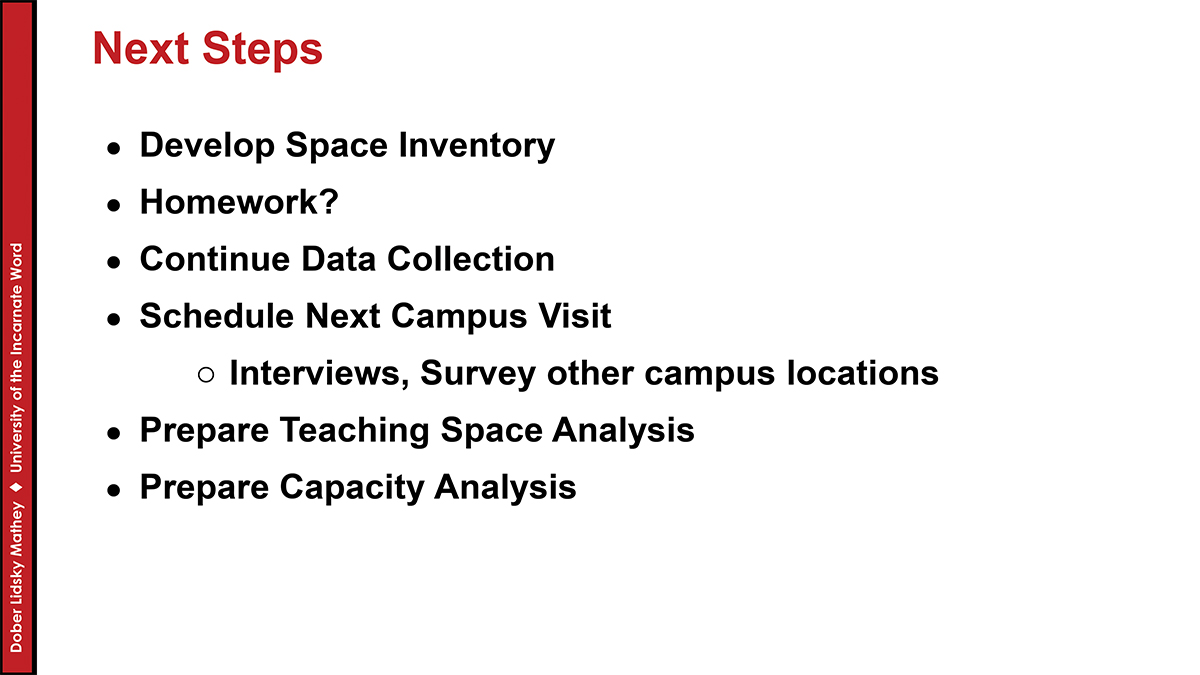
While the group was happy to be informed about the team’s subsequent tasks, it was the one-word Homework? suggestion that caught their attention:
“Homework? What kind of homework?”
“Homework? What would that look like?”
“Homework? What would you like us to do?”
Veterans of committee life will probably acknowledge that this is not the universal reaction to a request for more of their time, but this group was ready. Fortunately, the co-chairs had raised this issue in a pre-meeting – they had no interest in leading a passive process, and they had informed the members that they would be expected to be active participants. I asked each of the 24 committee members to list five “things” – outcomes, deliverables, results, projects, etc. – that they wanted to see the campus planning produce. They could approach it anyway they wanted, but their response had to, at a minimum, be a list of five items. In their role as ambassadors for and communicators of the campus planning, they were encouraged to reach out to others – individuals and groups they were connected to – other committees, departments, colleagues, friends to gather their input.
Within a month we had material from 25 respondents in a document compiled by an exceptionally committed task force member (also the Chair of the Faculty Senate that year) extending to 13 pages of single-space text. Based on our review, we at DLM took a cut at organizing the responses into themes that seemed appropriate to us, coming up with the structure excerpted below:
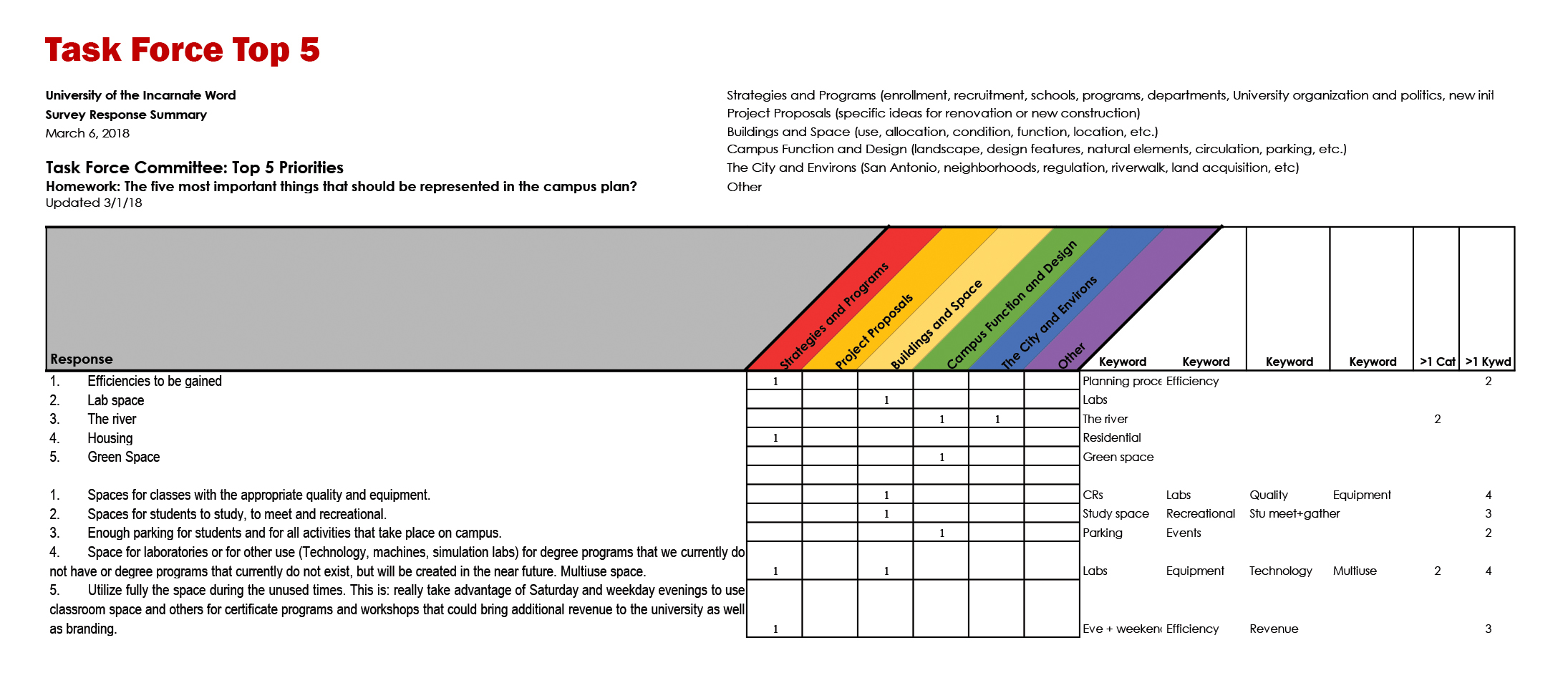
This matrix posited five theme categories (plus the always popular “Other”):
- Strategies and Programs
- Project Proposals
- Buildings and Space
- Campus Function and Design
- The City and Environs
- Other
And placed the suggestions embedded in the responses into the categories, extracting up to four keywords and phrases for each idea. We then tabulated the number of categories and keywords each idea generated as a rough gauge of “importance”. We presented our summary at the next task force meeting in March in the slide below.
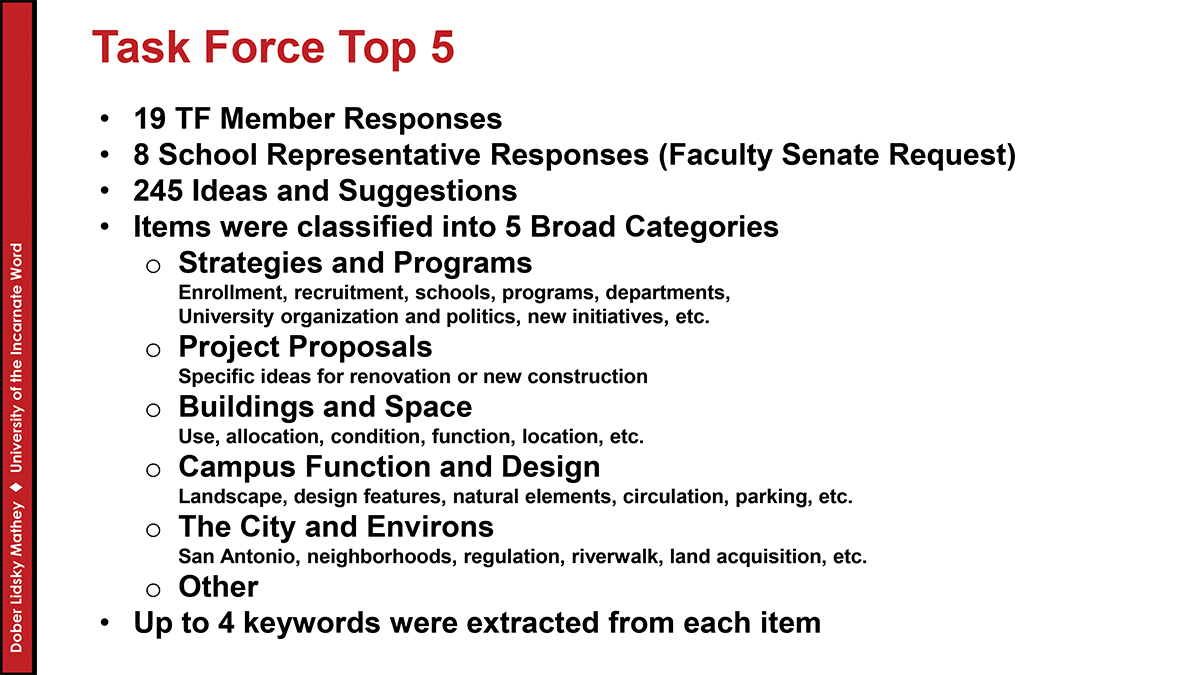
The items we tabulated from the response in each category were summarized on the slide:
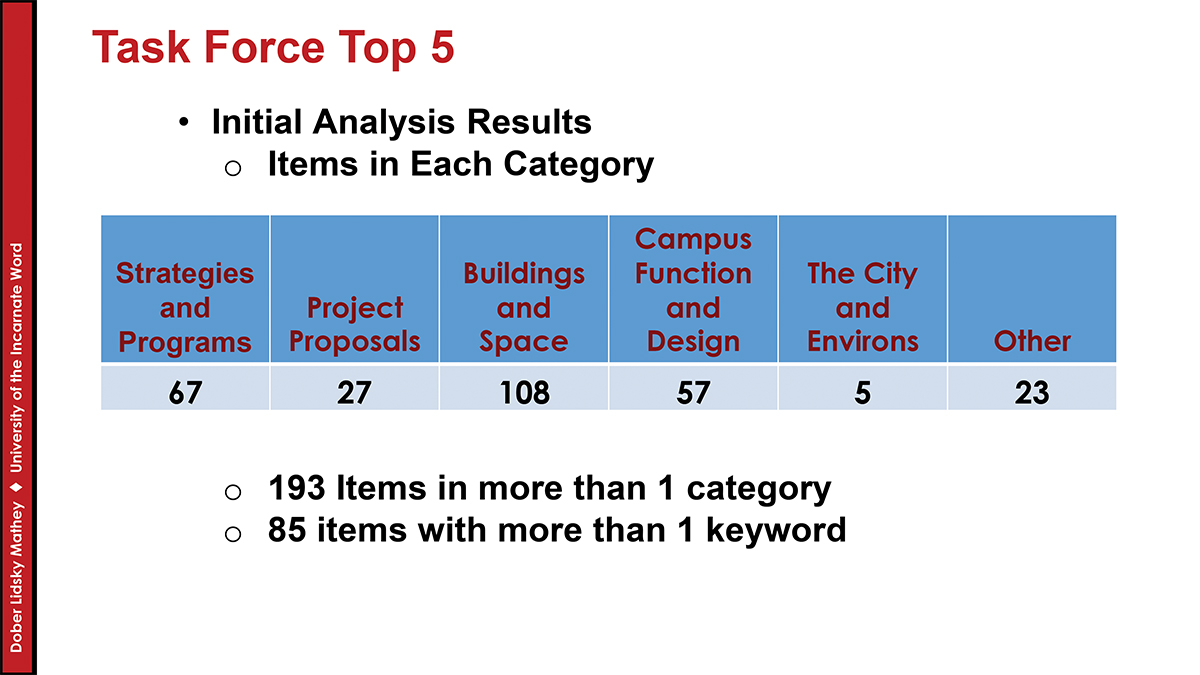
We identified a long list of keywords embedded in the response text and tabulated the frequency with which they appeared.
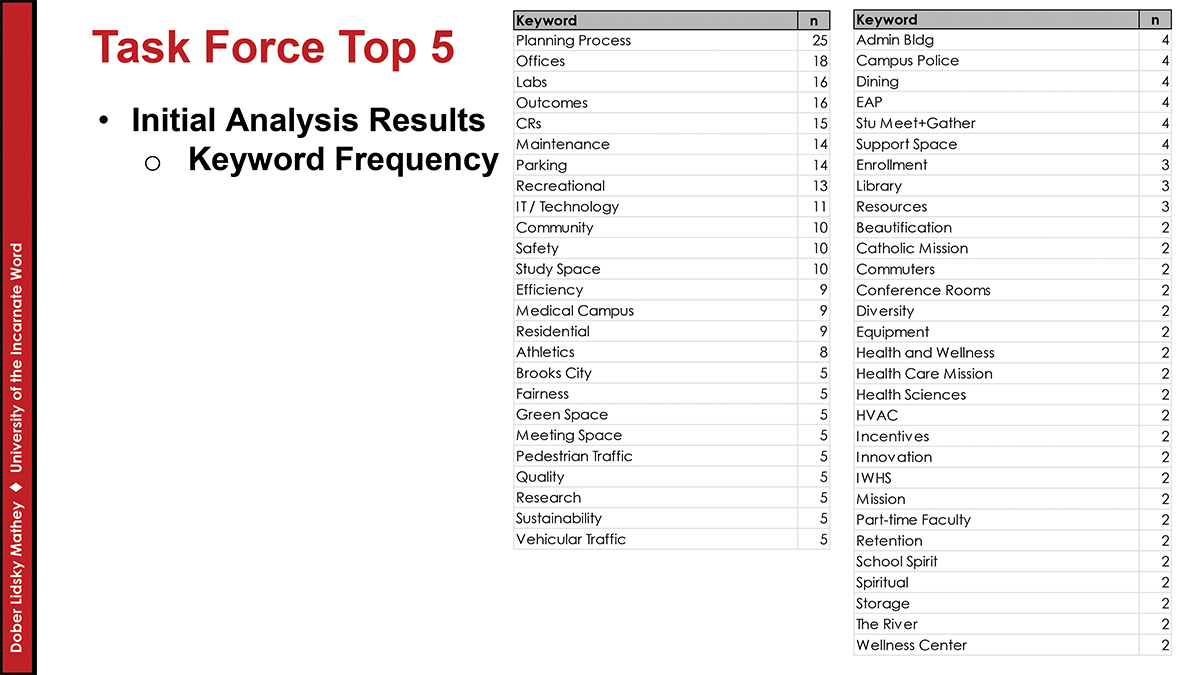
And we asked several questions to initiate a discussion about how the analysis could be improved.
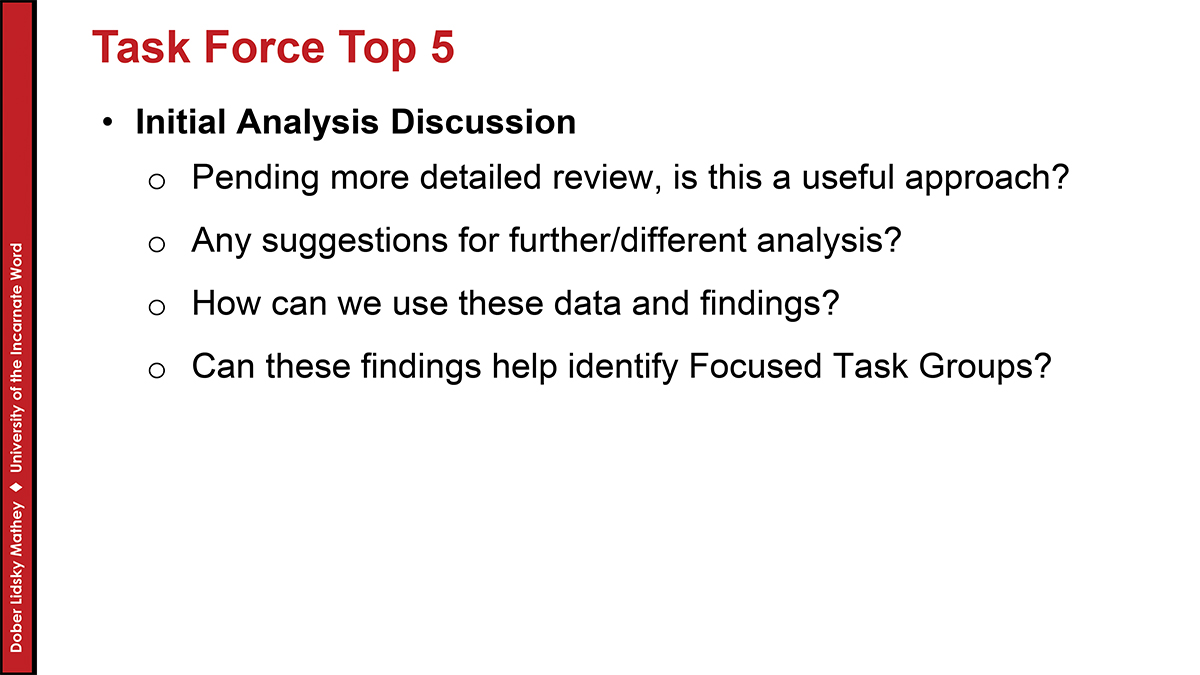
In the ensuing discussion, the Task Force agreed to prepare their own analysis of the responses to create a more locally meaningful summary. And a month later, at the next meeting, a group from the Task Force who would go on to spend hundreds of hours working with this material, described the revised and much improved summary list of themes as shown in the slide from their presentation:
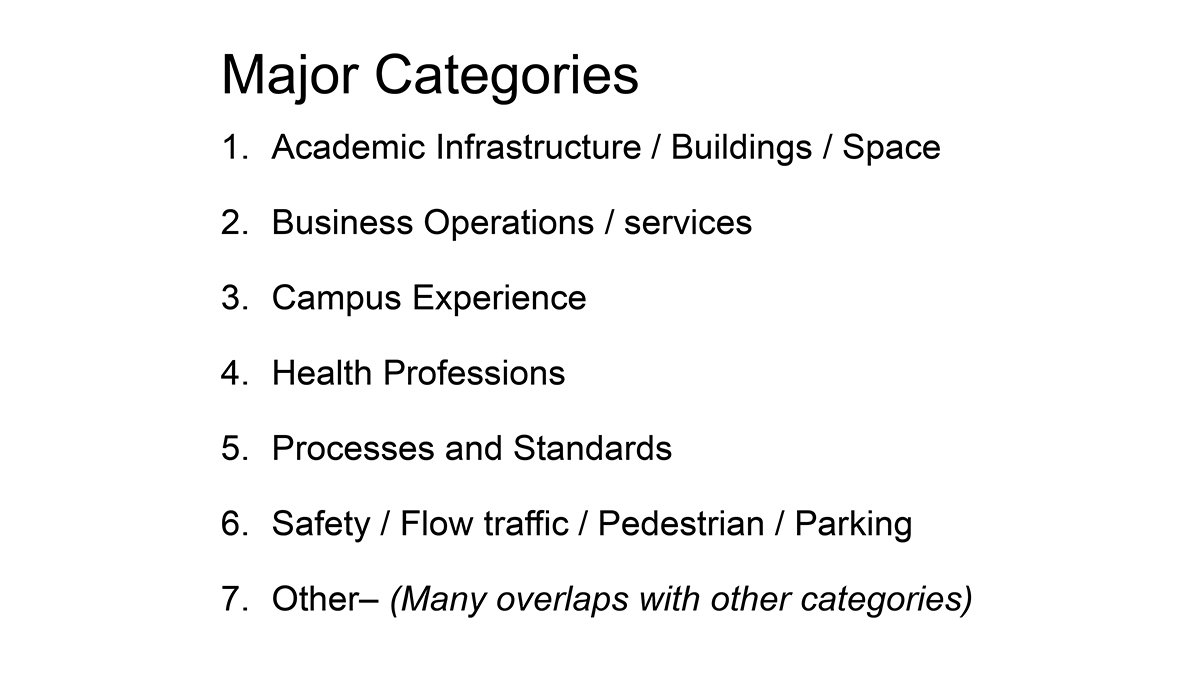
Each of the themes was discussed at some length with the general agreement to work more in developing these themes. At the next meeting in May, we suggested the Task Force create six Study Groups with members from the Task Force and from the broader university community – faculty, administrators, staff and students – whose charge would be to study the issues, confer with subject matter experts, and develop a white paper of perhaps five to ten pages to be presented at a symposium to be scheduled before the beginning of the new academic year in September. While the Study Group chairs (drawn from the Task Force) identified colleagues from the university community to invite to for their group, we collaborated with the Task Force chairs to draft the President’s charging/invitation letter and the Study Groups were established.
As the campus planning analyses advanced, and initial broad concepts were formulated, the groups worked from mid-May to early August to study their topics and prepare their findings. All but one of the six reports submitted exceeded the suggested maximum ten pages. All Study Group members came together on 23 August to present and discuss their findings. Several participants commented on the collegiality and quality of the experience and the opportunity to discuss issues across the university not typically taken up in committee work.
The findings and recommendations informed the further development of the campus plan concepts. The Task Force had become expert critics of the plan contributing valuable input to improving and refining plan concepts. They also became more confirmed advocates for the plan having studied its important aspects in depth.
Take-aways from this process:
- Strong leadership, clearly established by the President:
- Through his selection of the experienced, well-connected co-chairs
- By providing continuous support for their leadership of the Task Force
- With his attendance at all Task Force meetings (including the entire 4-hour Study Group presentation symposium)
Signaled to the university community that this was an important activity that he was expecting significant results from.
- The co-chairs’ active management of the process (extending beyond simply scheduling meetings to, for one example of many, collaborating and often initiating meeting agenda items) and insistence on homework for the Task Force reinforced the expectations for the process.
- Most particularly, the Task Force members’ own agency in volunteering to invest additional time to work through the technical and institutional issues raised by the planning analyses and process.
As a consultant this was an exemplary experience of committee (and campus community) engagement that made the campus planning process an intellectually stimulating pleasure.
It was also real-life proof of an observation made in a piece on the post-pandemic “new normal” for cities I recently read that had many concepts and suggestions transferable to campuses1:
“Preparing for the future city, then, won't mean to simply scan the fog ahead. Instead, the focus must be to shape and design the future.”
The Future of Cities: Back to Basics?
Klaus Philipsen, FAIA
The Future of Cities: Back to Basics? | Community Architect (archplanbaltimore.blogspot.com)
The important lesson for me of the UIW Task Force’s remarkable impact is to unapologetically expect big things from the committees we all work with. Actively design and energetically direct the engagement process instead of letting it take its own course out of concern the challenge might be rejected. Great things can happen!

George Mathey
________________________________
1 Many thanks to Altaf Mulla for his referral to this post
|







